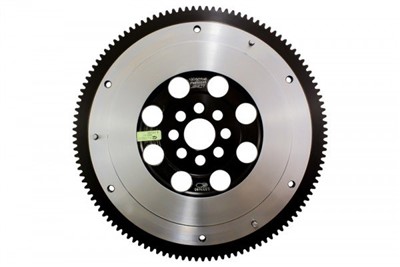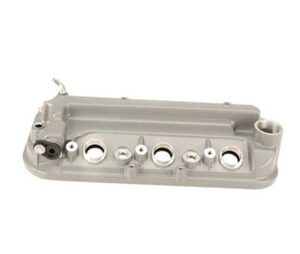Flywheel
A flywheel is an essential component in the realm of automotive engineering, serving as a heavy disc affixed to the end of a rotating shaft.
This pivotal device plays a multifaceted role in ensuring optimal engine performance. Firstly, it acts as a reservoir of rotational inertia, imparting stability to your vehicle’s engine by mitigating power pulses.
Moreover, the flywheel meticulously balances the engine, enhancing overall efficiency.
Facilitating the smooth initiation of your engine, the flywheel permits the seamless engagement of an electric starter.
Beyond these technical nuances, the flywheel establishes a critical link between the engine and transmission via a clutch, facilitating the transfer of power to the wheels.
As you consider your automotive needs, rest assured that our flywheel exemplifies precision engineering and reliability, ensuring a harmonious synergy within your vehicle’s intricate mechanics.
Explore the epitome of quality with our Flywheel, a testament to seamless performance and enduring value.
$120.00
CompareFlywheel
The flywheel is a crucial component in the drivetrain of an internal combustion engine, serving several important functions related to engine performance and smoothness. Its primary role is to store rotational energy and provide a consistent power output, contributing to the engine’s overall efficiency and operation.
Material and Construction
Flywheels are constructed from materials chosen for their strength, durability, and ability to withstand high rotational forces:
- Cast Iron: Traditional are often made from cast iron due to its high strength and durability. Cast iron provides the necessary mass to store and balance rotational energy effectively.
- Steel: Some modern use high-strength steel, which offers a good balance of strength and weight. Steel flywheels can be lighter than cast iron ones, contributing to improved performance.
- Aluminum: In high-performance applications, may be made from aluminum or aluminum alloys to reduce weight and improve engine response. Aluminum flywheels are typically lighter and more expensive but can offer better performance characteristics.
- Composite Materials: Advanced may incorporate composite materials for reduced weight and enhanced performance. These materials are designed to handle the stresses and strains of high-speed rotation.
Design and Functionality
The flywheel is designed with several key features to ensure its effectiveness in the engine’s operation:
- Energy Storage: The store’s rotational energy from the engine’s crankshaft. This stored energy helps to smooth out power delivery and maintain consistent engine speed by absorbing and releasing energy as needed.
- Balancing: The helps to balance the engine’s rotational forces. By smoothing out the engine’s power pulses, it reduces vibrations and contributes to a smoother operation.
- Clutch Operation: In manual transmission vehicles, the provides a mounting surface for the clutch. It ensures proper engagement and disengagement of the clutch, facilitating smooth gear changes and engine operation.
- Rotational Mass: The mass plays a crucial role in maintaining engine momentum. It helps to maintain engine speed and prevent stalling, especially at low RPMs.
Performance and Benefits
The flywheel contributes to several important aspects of engine performance and vehicle operation:
- Smooth Engine Operation: By storing and releasing rotational energy, the helps to smooth out engine power delivery, reducing vibrations and ensuring a more consistent and stable engine operation.
- Enhanced Performance: A well-designed can improve engine performance by maintaining consistent rotational speed and providing a stable power output, particularly in high-performance applications.
- Improved Clutch Operation: The surface provides a stable platform for clutch engagement, contributing to smoother gear changes and improved driving experience in manual transmission vehicles.
- Reduced Stalling: By maintaining engine momentum, the flywheel helps to reduce the likelihood of stalling, particularly at low engine speeds or during sudden changes in engine load.
Maintenance and Care
Proper maintenance and care of the flywheel are essential for ensuring its effectiveness and preventing potential issues:
- Regular Inspection: Periodically inspect the for signs of wear, such as cracks, warping, or excessive wear on the clutch surface. Address any issues promptly to prevent further damage.
- Check for Vibration: If you notice unusual vibrations or noises during engine operation, it may indicate problems with the Have the flywheel inspected and repaired or replaced if necessary.
- Clutch Maintenance: Regularly maintain the clutch system, including the flywheel, to ensure proper operation and longevity. Proper clutch maintenance can help prevent issues and extend the life of the flywheel.
- Professional Servicing: If you experience performance issues or suspect problems with the, consult a professional mechanic for inspection and servicing. Proper diagnosis and repair are essential for maintaining optimal performance.
Advanced Features and Technologies
Modern flywheels may include advanced features to enhance their performance and functionality:
- Dual-Mass Flywheels: Some vehicles use dual-mass, which consists of two separate flywheel components connected by a damping mechanism. Dual-mass flywheels help to reduce engine vibrations and improve overall comfort.
- Lightweight Designs: High-performance vehicles may use lightweight made from aluminum or composite materials to reduce rotational mass and improve engine response.
- Integrated Sensors: Advanced may include integrated sensors to monitor rotational speed and performance. These sensors provide real-time data for diagnostics and optimization.
- High-Performance Materials: used in high-performance applications may incorporate advanced materials and coatings to enhance durability and performance under extreme conditions.
Conclusion
The flywheel is a vital component in the drivetrain of an internal combustion engine, responsible for storing rotational energy, balancing engine forces, and ensuring smooth engine operation. Its durable construction, effective energy storage, and role in clutch operation contribute to overall engine performance and reliability. Regular maintenance and timely care of the flywheel are important for preventing issues and ensuring optimal operation. By understanding the functions and benefits of the flywheel, vehicle owners can maintain a smooth and efficient engine performance.
Based on 0 reviews
Be the first to review “Flywheel” Cancel reply
Related products
-
Engine
Harmonic Balancer (Crank Pulley)
0 out of 5(0)The Harmonic Balancer (Crank Pulley) stands as a pivotal component in automotive engineering, seamlessly marrying functionality with precision.
Crafted from a blend of robust metal and resilient rubber, this circular device finds its purpose at the forefront of the crankshaft. Its primary role lies in the adept absorption of vibrations, ensuring a smooth and stable engine performance.
Affixed to the crank pulley, this harmonious union extends its influence to drive essential accessories such as the air conditioner, amplifying its significance in the vehicle’s functionality.
Engineered for optimal efficiency, the internal rubber composition meticulously mitigates vibrations, maintaining an equilibrium that safeguards the engine’s integrity.
The Harmonic Balancer is not just a component; it’s a testament to innovative design and reliability, ensuring your automotive experience remains harmoniously balanced.
SKU: n/a -
Engine
Timing Chain
0 out of 5(0)Introducing our Precision Timing Chain, a vital component meticulously designed to synchronize the intricate dance between the crankshaft and camshaft(s) in your engine.
Crafted for optimal precision, this timing chain ensures seamless coordination, guaranteeing accurate timing for the precise opening and closing of engine valves during each cylinder’s firing cycle.
Built to withstand the rigors of engine dynamics, our timing chain boasts durability that exceeds industry standards.
Engineered for longevity, it operates within the heart of your engine, requiring periodic oil maintenance to ensure peak performance.
When it comes to reliability and efficiency, our timing chain stands as the epitome of excellence.
Experience the epitome of timing precision with our Timing Chain, a testament to engineering ingenuity. Our commitment is to deliver unrivaled performance, setting the benchmark for quality and durability in every rotation.
SKU: n/a -
Engine
OCC Chopper CNC Mount For 2-Stroke 66CC-80CC Gas Motorized Engine
0 out of 5(0)Introducing the OCC Chopper CNC Mount for 2-Stroke 66CC/80CC Gas Motorized Engines—a precision-engineered solution for optimal engine placement on your OCC Chopper Frame.
Crafted from lightweight Aluminum, this CNC Engine Mount is exclusively designed for use with our 2-stroke Chinese 66cc/80cc Engine or similar models, ensuring a perfect fit.
Experience reduced kit weight and enhanced vibration resistance, thanks to the aluminium construction, providing stability during your rides.
The sleek design not only adds an aesthetic touch but also offers a perfect offset to align your drive sprocket seamlessly with the rear one.
This mount is a paragon of stability, providing a secure foundation for your engine.
Noteworthy for its accuracy, the OCC Chopper CNC Mount offers ample space for customization, allowing easy integration of high-performance parts such as Mikuni and clone carburetors.
Elevate your riding experience with this superior-quality CNC mount—a testament to precision engineering and durability.
Explore the possibilities of enhanced performance and style with OCC Chopper CNC Mount.
SKU: n/a -
Engine
Clutch Master Cylinder
0 out of 5(0)The Clutch Master Cylinder, an integral component of hydraulic clutch systems, plays a pivotal role in transmitting force seamlessly from the clutch pedal to the slave cylinder.
Engineered with precision, this hydraulic marvel operates on a straightforward principle, ensuring optimal performance in every engagement.
The master cylinder, connected to the clutch pedal through a meticulously designed lever mechanism, exemplifies efficiency and reliability.
Crafted for compatibility with a variety of brands, our Clutch Master Cylinder stands as a testament to quality and durability.
Its robust design ensures smooth and responsive clutch operation, enhancing the overall driving experience.
Trust in the seamless functionality of our Clutch Master Cylinder, a key player in hydraulic clutch systems, designed to meet the highest standards of performance and longevity.
Elevate your driving experience with confidence, as our product guarantees precision and reliability across diverse automotive brands.
SKU: n/a -
Engine
Valve Cover
0 out of 5(0)The Valve Cover, also known as a rocker cover, stands as a crucial engine component, crafted from durable plastic or metal and securely bolted atop the cylinder head.
Its significance lies in the preservation of engine health and performance by effectively containing oil within the engine.
This integral part prevents oil leaks and ensures optimal functioning. Engineered for longevity and reliability, our valve covers are designed to meet the highest standards, catering to a wide range of vehicles, including LS models.
Each valve cover seamlessly integrates with the engine, forming a secure seal with the assistance of a high-quality valve cover gasket.
Enhance your engine’s longevity and performance with our premium valve covers a testament to precision engineering and durability.
Choose excellence for your vehicle, as our valve covers are crafted to exceed expectations, offering a perfect fit for various car models.
SKU: n/a









There are no reviews yet.